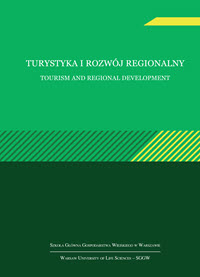Main Article Content
Article Details
ABTA research reveals year-on-year rise in solo travellers (2024). Available online: https://www.abta. com/news/abta-research-reveals-year-year-rise-solo-travellers (access: 24.03.2024).
Bianchi, C. (2022). Antecedents of tourists' solo travel intentions. Tourism Review, 77 (3), p. 780-795. DOI: https://doi.org/10.1108/TR-12-2020-0611 (Crossref)
Chai, P. P. (1996). Fully independent travellers. BTR Tourism Update, Autumn, 3.
Gitnux Marketdata Report 2024 „Solo Travel Statistics: Market Report & Data". Available online: www: gitnux.org/solo-travel-statistics (access: 24.03.2024).
Global Solo Travel Market 2024-2033. Available online: https://www.custommarketinsights.com/re-port/solo-travel-market/ (access: 24.03.2024).
Hamid, S., Ali, R., Azhar, M., Khan, S. (2021). Solo Travel and Well-Being Amongst Women: An Exploratory Study. Indonesian Journal of Tourism and Leisure, 2 (1), p. 1-13. (Crossref)
Huang, S., Shao, Y, Zeng, Y., Liu, X., Li, Z. (2021). Impacts of COVID-19 on Chinese nationals' tourism preferences. Tourism Management Perspectives, 40. DOI: https://doi.org/10.1016/ j.tmp.2021.100895 (Crossref)
Jonas, L. C. (2022). Solo Tourism: A Great Excuse to Practice Social Distancing. African Journal of Hospitality. Tourism and Leisure, 11, p. 556-564.
Karagdz, D., Ifyk, C., Dogru, T, Zhang, L. (2021). Solo Female Travel Risks, Anxiety and Travel Intentions: Examining the Moderating Role of Online Psychological-Social Support. Current Issues in Tourism, 24, p. 1595-1612. (Crossref)
Karantzavelou, V. (2018). Solo travel soars in popularity: 42% increase in bookings since 2015. Travel Daily News. Available online: https://www.traveldailynews.com/post/solo-travel-soars-in-pop-ularity-42-increase-in-bookings-since-2015 (access: 24.03.2024).
Klinenberg, E. (2012). Going solo: The extraordinary rise and surprising appeal of living alone. London: Penguin Books.
Laesser, C., Beritelli, P., Bieger, T. (2009). Solo travel: Explorative insights from a mature market (Switzerland). Journal of Vacation Marketing, 15 (3), p. 217-227. (Crossref)
Lisella, M. (2019). The unstoppable trend: Solo travel growing and going just about anywhere. Travel Market Report. 2022 Global Travel Trends Report. Available online: https://www.ameri-canexpress.com/en-us/travel/discover/get-inspired/global-travel-trends-en-gb-2022 (access: 24.03.2024).
Naderifar, M., Goli, H., Ghaljaie, F. (2017). Snowball sampling: A purposeful method of sampling in qualitative research. Strides in Development of Medical Education (14), e67670. (Crossref)
Sadler, G. R., Lee, H. C., Lim, R. S., Fullerton, J. (2010). Recruitment of hard-to-reach population subgroups via adaptations of the snowball sampling strategy. Nursing & Health Sciences, 12, p. 369-374. DOI: https://doi.Org/10.llll/j.1442-2018.2010.00541.x (Crossref)
Sainchez-Peirez, M., Terain-Yeipez, E., Mariin-Carrillo, M. B., Mariin-Carrillo, G. M., Illescas-Manzano, M. D. (2021). The impact of the COVID-19 health crisis on tourist evaluation and behavioural intentions in Spain: Implications for market segmentation analysis. Current Issues in Tourism, 24 (7), p. 919-933. DOI: https://doi.org/10.1080/13683500.2021.1889481 (Crossref)
Santos, H. C., Varnum, M. E. W., Grossmann, I. (2017). Global increases in individualism, Psychological Science, 28 (9), p. 1228-1239. DOI: https://doi.org/10.1177/0956797617700622 (Crossref)
Travel Predictions 2024, Available online: https://www.booking.eom/c/trends/travelpredictions2024. en-gb.html?aid=356980&label=gog235jc-lDEhd0cmF2ZWwtcHJlZGljdGlvbnMtMjAyNCiCA-jjoB0gzWANotgGIAQGYAQm4ARflAQzYAQPoAQGIAgGoAgO4AuuTgLAGwAIB0glkYmMyNWIzY TMtZmNlMS00NDc2LWIxZGYtNGIzMTgwZDg3OThl2AIE4AIB&sid=f60flc268c8cae99c2ead4el 4da0c7e9&keep_landing=l& (access: 24.03.2024).
Voicu, M. C. (2011). Using the Snowball Method in Marketing Research on Hidden Populations. Challenges of the Knowledge Society, 1, p. 1341-1351.
What Does Solo Travel Actually Mean? Available online: https://www.solotravel365.com/travel-guide/ solo-travel/what-does-solo-travel-actually-mean/ (access: 19.03.2024).
Wilson, E., Little, D. E. (2008). The solo female travel experience: exploring the 'geography of women's fear'. Current Issues in Tourism, 11 (2), p. 167-186. (Crossref)
Yang, R., Tung, V. W. S. (2018). How does family influence the travel constraints of solo travelers? Construct specification and scale development. Journal of Travel & Tourism Marketing, 35 (4), p. 507-516. (Crossref)
Yang, E. C. L. (2021). What motivates and hinders people from travelling alone? A study of solo and non-solo travellers. Current Issues in Tourism, 1 (14), p. 2458-2471. (Crossref)
Downloads
- Katarzyna Gralak, Ocena zagospodarowania Szlaku Konnego Puszczy Augustowskiej i Mazur (na obszarze Nadleśnictwa Augustów) , Turystyka i Rozwój Regionalny: Nr 21 (2024)
Możesz również Rozpocznij zaawansowane wyszukiwanie podobieństw dla tego artykułu.
- Jan Zawadka, Anna Ivolga, Tourist popularity of Poland among the inhabitants of Stavropol Krai , Turystyka i Rozwój Regionalny: Nr 7 (2017)
- Jan Zawadka, Atrakcyjność turystyczna wybranych krajów basenu Morza Śródziemnego , Turystyka i Rozwój Regionalny: Nr 5 (2016)
- Jan Zawadka, Społeczno-ekonomiczne uwarunkowania rozwoju działalności agroturystycznej , Turystyka i Rozwój Regionalny: Nr 1 (2014)
- Jolanta Cichowska, Aleksandra Mreła, Jan Zawadka, Analysis of demand for qualified tourism organized by branches of the Polish Tourist and Sightseeing Society (using fuzzy relations) , Turystyka i Rozwój Regionalny: Nr 21 (2024)

Utwór dostępny jest na licencji Creative Commons Uznanie autorstwa – Użycie niekomercyjne 4.0 Międzynarodowe.





